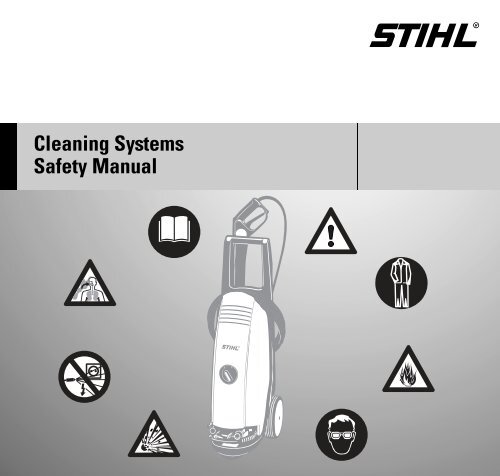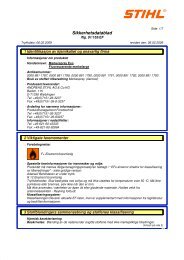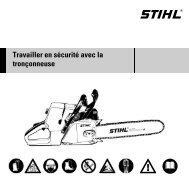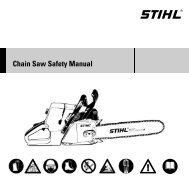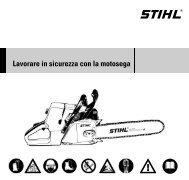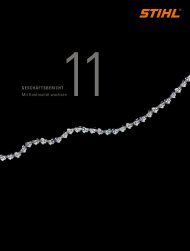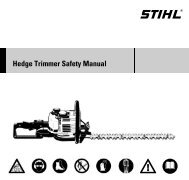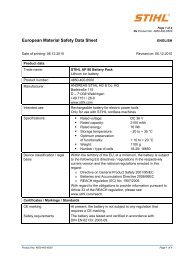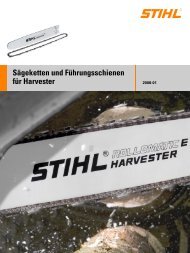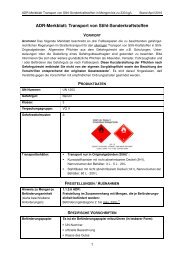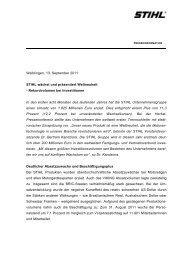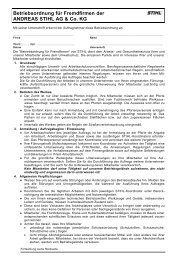Cleaning Systems Safety Manual - Stihl Shop Hamilton
Cleaning Systems Safety Manual - Stihl Shop Hamilton
Cleaning Systems Safety Manual - Stihl Shop Hamilton
You also want an ePaper? Increase the reach of your titles
YUMPU automatically turns print PDFs into web optimized ePapers that Google loves.
<strong>Cleaning</strong> <strong>Systems</strong><br />
<strong>Safety</strong> <strong>Manual</strong><br />
STIH)
BA_SE_137_002_01_01.fm<br />
Printed on chlorine-free paper.<br />
Printing inks contain vegetable oils; paper can be recycled.<br />
© ANDREAS STIHL AG & Co. KG, 2006<br />
0457 190 0121. M3,5. K6. Sä. Printed in Germany<br />
Contents<br />
<strong>Safety</strong> precautions and working<br />
techniques (cold water<br />
high-pressure cleaners) .................... 2<br />
<strong>Safety</strong> precautions and working<br />
technique (hot water<br />
high-pressure cleaners)..................... 5<br />
Important safety instructions<br />
(wet/dry vacuums) ............................. 9<br />
Main parts of the machine .............. 10<br />
Main parts of the machine .............. 11<br />
Main parts of the machine .............. 13<br />
STIHl<br />
<strong>Cleaning</strong> <strong>Systems</strong> <strong>Safety</strong> <strong>Manual</strong><br />
English<br />
This booklet summarizes the detailed<br />
instructions relating to safety and<br />
working technique contained in the<br />
individual instruction manuals for STIHL<br />
cleaning systems. With the aid of this<br />
booklet, even long-standing users of a<br />
cleaning system can familiarize<br />
themselves – in their own best interests<br />
– with the latest findings for working<br />
safely with a cleaning system.<br />
Note that the illustrations in the chapter<br />
"Main parts" show the high-pressure<br />
cleaners RE 107, RE 117,<br />
RE 127 PLUS, RE 521, RE 551 PLUS<br />
and RE 581 PLUS by way of example,<br />
as well as the vacuum SE 121.<br />
Other cleaning system models may<br />
feature different operating elements.<br />
This booklet also contains references to<br />
various chapters in the instruction<br />
manuals of the individual machines.<br />
It therefore goes without saying that the<br />
instruction manual for the cleaning<br />
system concerned must always also be<br />
consulted without fail.<br />
Contact your STIHL dealer if you have<br />
any further queries after reading this<br />
booklet.<br />
1
English<br />
<strong>Safety</strong> precautions and<br />
working techniques<br />
General<br />
The high water pressure<br />
generated by the<br />
machine and its electrical<br />
connections are a<br />
particular source of<br />
danger.<br />
The following safety<br />
precautions must be read<br />
and understood before<br />
using the machine for the<br />
first time. Keep the<br />
manual in a safe place for<br />
future reference.<br />
Non-compliance with the owner's<br />
manual may cause serious or even fatal<br />
injury.<br />
Note the national safety regulations<br />
issued, for example, by the employers'<br />
liability insurance association, social<br />
security institutions, occupational safety<br />
and health authorities or other<br />
organizations.<br />
The machine may only be used by duly<br />
trained and authorized operators.<br />
Ensure that the operating instructions<br />
are available to all users.<br />
The high-pressure cleaner must never<br />
be used by adolescents.<br />
2<br />
The machine must not be altered or<br />
modified in any way, as this may<br />
endanger your personal safety.<br />
The high-pressure cleaner can be used<br />
to clean motor vehicles, machines,<br />
tanks, facades, stables and to remove<br />
rust without dust or sparks.<br />
Other uses are not permitted and may<br />
lead to accidents or damage to the<br />
machine. The machine must not be<br />
modified in any way – this may also lead<br />
to accidents or damage to the machine.<br />
High-pressure hoses, fittings and<br />
couplings are very important for the<br />
safety of the machine. Only highpressure<br />
hoses, fittings, couplings and<br />
other accessories which have been<br />
approved by STIHL for this machine or<br />
technically equivalent parts may be<br />
mounted on the machine. Contact a<br />
dealer if in doubt. Use only high-quality<br />
accessories, in order to avoid the risk of<br />
accidents or damage to the machine.<br />
STIHL recommends the use of genuine<br />
STIHL accessories. Such parts have<br />
been optimized for the machine and the<br />
user's requirements.<br />
Unsuitable extension leads may be<br />
dangerous.<br />
When using extension leads, ensure<br />
that the minimum conductor crosssections<br />
are maintained<br />
(refer to the chapter "Connect machine<br />
to power supply").<br />
When using extension leads, the<br />
connector and coupling must be<br />
waterproof or routed in such a way that<br />
they cannot come into contact with<br />
water.<br />
All plugs and connectors must be at<br />
least splashproof.<br />
The machine may only be operated if all<br />
parts are undamaged. Pay particular<br />
attention to the power cable, mains plug,<br />
high-pressure hose, spray attachment<br />
and safety mechanisms.<br />
The high-pressure hose must not be<br />
driven over, pulled, buckled or twisted.<br />
Never pull the high-pressure hose in<br />
order to move the machine.<br />
<strong>Cleaning</strong> <strong>Systems</strong> <strong>Safety</strong> <strong>Manual</strong>
Never operate the machine with a<br />
damaged high-pressure hose –<br />
it must be replaced immediately.<br />
The high-pressure hose must be<br />
approved for the permissible excess<br />
pressure of the machine.<br />
The permissible excess pressure, the<br />
maximum permitted temperature and<br />
the date of manufacture are stated on<br />
the cladding of the high-pressure hose.<br />
The permissible pressure and date of<br />
manufacture are specified on the fittings.<br />
Unsuitable detergents can cause<br />
damage to health, as well as to the<br />
machine and the object to be cleaned.<br />
Contact a dealer if in doubt.<br />
STIHL recommends the use of genuine<br />
STIHL detergents. Note the instructions<br />
for use (refer to the catalogue of<br />
chemical detergents).<br />
Chemical detergents may contain<br />
physiologically harmful (toxic, caustic,<br />
irritant), flammable or explosive<br />
substances. Note the manufacturer's<br />
safety data sheets!<br />
<strong>Cleaning</strong> <strong>Systems</strong> <strong>Safety</strong> <strong>Manual</strong><br />
Clothing and equipment<br />
Wear shoes with non-slip soles.<br />
Wear goggles and<br />
protective clothing.<br />
STIHL recommends that a boilersuit be<br />
worn in order to reduce the risk of injury<br />
due to accidental exposure to the highpressure<br />
jet.<br />
Transporting the machine<br />
When transporting the machine in or on<br />
a vehicle, it must be secured, e.g. with<br />
straps, so that it cannot slip or tip over.<br />
The use of anti-freeze is recommended<br />
if the machine and accessories are to be<br />
transported at temperatures near or<br />
below 0 °C (32 °F); refer to the chapter<br />
"Storing the machine".<br />
English<br />
During work<br />
Never spray water onto<br />
electrical appliances -<br />
risk of short-circuiting!<br />
Never direct the highpressure<br />
jet or water hose<br />
against the machine itself<br />
or against other electrical<br />
appliances and<br />
equipment - risk of shortcircuiting!<br />
Never direct the highpressure<br />
jet against<br />
yourself or other people,<br />
not even to clean clothing<br />
or shoes -<br />
serious injuries may<br />
result!<br />
Never use the machine<br />
when there are people without protective<br />
clothing in the working area.<br />
Do not direct the high-pressure jet<br />
against animals.<br />
Keep children, animals and bystanders<br />
at a safe distance.<br />
3
English<br />
Hazardous substances (such as<br />
asbestos or oil) must not be allowed to<br />
escape into the environment unchecked<br />
when working with the machine.<br />
The applicable environmental<br />
regulations must be observed without<br />
fail!<br />
Surfaces of asbestos cement must<br />
never be cleaned with a high-pressure<br />
jet, as hazardous, breathable asbestos<br />
fibres may be released in addition to the<br />
dirt. The danger is greatest when the<br />
washed surface has dried.<br />
The machine must<br />
immediately be<br />
unplugged from the<br />
mains supply if the power<br />
cable is damaged -<br />
danger due to electric<br />
shock.<br />
Delicate parts made of rubber, fabric or<br />
similar materials must not be cleaned<br />
with a pencil jet, e.g. from the rotary<br />
nozzle. Maintain a sufficient distance<br />
between the high-pressure nozzle and<br />
the surface in order to avoid damaging<br />
the surface to be cleaned.<br />
4<br />
The trigger on the spray gun must move<br />
easily and automatically return to its<br />
starting position when released.<br />
Always check that the machine is in<br />
good working order before starting work.<br />
Pay particular attention to the power<br />
cable, mains plug, high-pressure hose,<br />
spray attachment and safety<br />
mechanisms.<br />
The machine may only be operated in an<br />
upright position.<br />
Do not cover the machine and ensure<br />
adequate motor ventilation.<br />
Keep the high-pressure cleaner as far<br />
away as possible from the object being<br />
cleaned.<br />
Ensure that the power cable is not<br />
damaged by being driven over,<br />
squashed or pulled, etc.<br />
Never disconnect the machine by pulling<br />
the cable out of the socket: always grip<br />
the plug itself.<br />
The power cable and mains plug must<br />
never be touched with wet hands!<br />
Always unroll the power cable from the<br />
cable drum completely to avoid all risk of<br />
fire due to overheating.<br />
Hold the spray attachment firmly with<br />
both hands in order safely to withstand<br />
the kickback force and additional torque<br />
produced when using spray attachments<br />
with angled spray lance.<br />
Always ensure a firm and safe footing.<br />
The voltage and frequency specified for<br />
the machine (see rating plate) must<br />
match those of the mains power supply.<br />
<strong>Safety</strong> device<br />
When the safety device is tripped, any<br />
impermissibly high pressure will be<br />
diverted back to the intake side of the<br />
high-pressure pump via an overflow<br />
valve.<br />
This safety device is set by the<br />
manufacturer and must not be adjusted.<br />
<strong>Cleaning</strong> <strong>Systems</strong> <strong>Safety</strong> <strong>Manual</strong>
Maintenance and repairs<br />
Before starting any work on the<br />
machine:<br />
always disconnect the machine from the<br />
mains power supply.<br />
The machine must be serviced regularly.<br />
Do not attempt any maintenance or<br />
repair work not described in the owner's<br />
manual. All other work should be carried<br />
out by a servicing dealer.<br />
STIHL recommends that maintenance<br />
and repair work be carried out only by<br />
authorized STIHL dealers. STIHL<br />
dealers receive regular training and are<br />
supplied with technical information.<br />
Use only high-quality replacement parts,<br />
in order to avoid the risk of accidents or<br />
damage to the machine. Contact a<br />
dealer if in doubt.<br />
STIHL recommends the use of genuine<br />
STIHL spare parts. Such parts have<br />
been optimized for the machine and the<br />
user's requirements.<br />
The power cable may only be repaired<br />
or replaced by authorized and qualified<br />
electricians.<br />
<strong>Cleaning</strong> <strong>Systems</strong> <strong>Safety</strong> <strong>Manual</strong><br />
<strong>Safety</strong> precautions and<br />
working technique<br />
General<br />
The high water pressure<br />
generated by the<br />
machine and its electrical<br />
connections are a<br />
particular source of<br />
danger.<br />
Read the entire user<br />
manual through carefully<br />
before starting the<br />
machine for the first time<br />
and keep it in a safe place<br />
for future reference.<br />
Non-compliance with these instructions<br />
can prove fatal.<br />
Note all safety instructions specific to<br />
your country, such as those issued by<br />
the employers' liability insurance<br />
association, social insurance<br />
institutions, public authorities<br />
responsible for occupational safety and<br />
others.<br />
The machine may only be used by duly<br />
trained and authorized operators.<br />
Ensure that the user manual is available<br />
to all users.<br />
The high-pressure cleaner must never<br />
be used by adolescents.<br />
English<br />
The machine must not be altered or<br />
modified in any way, as this may<br />
endanger your personal safety.<br />
The high-pressure cleaner can be used<br />
to clean motor vehicles, machines,<br />
tanks, façades, stables and for removing<br />
rust without dust or sparks.<br />
The machine must not be used for other<br />
purposes, otherwise it may be damaged<br />
and/or cause accidents. It must not be<br />
altered or modified in any way, as this<br />
may also lead to accidents or damage<br />
the machine.<br />
High-pressure hoses, fittings and<br />
couplings are very important for the<br />
safety of the machine. Only use<br />
high-pressure hoses, fittings, couplings<br />
and other accessories which have been<br />
approved by STIHL for use on this<br />
machine or technically equivalent parts.<br />
Contact your dealer in case of doubt.<br />
Only use high-quality accessories in<br />
order to avoid the risk of accidents or<br />
damage to the machine.<br />
STIHL recommends the use of genuine<br />
STIHL accessories, as these are<br />
optimally adapted to the machine and<br />
the requirements of the user.<br />
5
English<br />
Unsuitable extension leads can be<br />
dangerous.<br />
When using extension leads, ensure<br />
that the minimum conductor<br />
cross-sections are maintained<br />
(refer to the chapter entitled "Connecting<br />
the machine to the power supply").<br />
When using an extension lead, ensure<br />
that the plug and socket are watertight or<br />
route the lead so that they cannot come<br />
into contact with water.<br />
The plug connectors and couplings on<br />
power cables must at least have<br />
splash-proof enclosures.<br />
The machine may only be used when<br />
all parts are in perfect working order.<br />
Particular attention must be devoted to<br />
the power cable and mains plug, the<br />
high-pressure hose with spray<br />
attachment and to the safety parts.<br />
The high-pressure hose must not be<br />
driven over, pulled, buckled or twisted.<br />
Never pull the high-pressure hose in<br />
order to move the machine.<br />
6<br />
Never operate the machine with a<br />
defective high-pressure hose – ensure<br />
that it is replaced immediately.<br />
The high-pressure hose must be<br />
approved for the permissible excess<br />
pressure of the machine.<br />
The permissible excess pressure, the<br />
maximum permitted temperature and<br />
the date of manufacture are stated on<br />
the cladding of the high-pressure hose.<br />
The permissible pressure and date of<br />
manufacture are specified on the fittings.<br />
Unsuitable chemicals can cause<br />
damage to health, as well as to the<br />
machine and the object to be cleaned.<br />
Contact your dealer if in doubt.<br />
STIHL recommends the use of STIHL<br />
chemicals. Note the directions for use<br />
(refer to the catalogue of chemicals).<br />
Chemicals may contain physiologically<br />
harmful (toxic, caustic, irritant),<br />
flammable or explosive substances.<br />
Note the manufacturer's safety<br />
data sheets.<br />
Personal protection<br />
Wear shoes with non-slip soles.<br />
Wear goggles and<br />
protective clothing.<br />
STIHL recommends that a boilersuit be<br />
worn in order to reduce the risk of injury<br />
due to accidental exposure to the<br />
high-pressure jet.<br />
Transporting the machine<br />
So that the machine can be transported<br />
safely on or in a vehicle, it must be<br />
secured with straps so that it cannot<br />
slip or tip over and the brake applied.<br />
Antifreeze is recommended if the<br />
machine and accessories are to be<br />
transported at temperatures near or<br />
below 0 °C (32 °F), refer to the chapter<br />
entitled "Storage".<br />
<strong>Cleaning</strong> <strong>Systems</strong> <strong>Safety</strong> <strong>Manual</strong>
During work<br />
Never spray electrical<br />
appliances with water –<br />
risk of short-circuiting!<br />
Never direct the<br />
high-pressure jet or water<br />
hose onto the machine<br />
itself or onto other<br />
electrical appliances or<br />
machines – risk of<br />
short-circuiting!<br />
Never direct the jet of<br />
liquid towards yourself<br />
or other people, not<br />
even in order to clean<br />
clothing or shoes –<br />
risk of injury!<br />
Never use the machine when there are<br />
people without protective clothing in the<br />
working area.<br />
Do not direct the high-pressure jet<br />
against animals.<br />
Keep children, animals and bystanders<br />
at a safe distance.<br />
<strong>Cleaning</strong> <strong>Systems</strong> <strong>Safety</strong> <strong>Manual</strong><br />
For reasons of hygiene, the machine<br />
cannot be used to clean surfaces which<br />
come into contact with foods.<br />
Hazardous substances (such as<br />
asbestos or oil) must not be allowed to<br />
escape into the environment unchecked<br />
when working with the machine.<br />
The relevant environment regulations<br />
must be observed without fail!<br />
Do not use the high-pressure jet or<br />
steam jet to clean any surfaces<br />
containing asbestos cement, as<br />
dangerous breathable asbestos fibres<br />
may be released in addition to the dirt.<br />
The danger is greatest when the<br />
correspondingly cleaned surface has<br />
dried.<br />
Do not smoke near the machine and<br />
when working with it – risk of fire!<br />
The fuel tank may give off inflammable<br />
vapours.<br />
Pull the plug immediately<br />
if the power cable is<br />
damaged – danger due<br />
to electric shocks!<br />
English<br />
Delicate parts made of rubber, fabric or<br />
similar materials must not be cleaned<br />
with a pencil jet, e.g. from the rotary<br />
nozzle. Maintain a sufficient distance<br />
between the high-pressure nozzle and<br />
the surface in order to avoid damaging<br />
the surface to be cleaned.<br />
Toxic gases are produced<br />
in hot-water operation;<br />
these gases may be<br />
odourless and invisible.<br />
Never operate the<br />
machine in enclosed or<br />
poorly ventilated rooms.<br />
Risk of poisoning!<br />
The trigger on the spray gun must move<br />
easily and automatically return to its<br />
starting position when released.<br />
Always check that the machine is in<br />
good working order before starting work.<br />
Particular attention must be devoted<br />
to the power cable and mains plug,<br />
the high-pressure hose with spray<br />
attachment and to the safety parts.<br />
Check the oil level.<br />
7
English<br />
Do not cover the machine and ensure<br />
adequate motor ventilation.<br />
Keep the high-pressure cleaner as far<br />
away as possible from the object being<br />
cleaned.<br />
The fuel tank may only be filled when the<br />
machine is switched off and the heat<br />
exchanger is cold. Do not smoke and<br />
keep the machine away from naked<br />
lights.<br />
Switch off the machine before filling with<br />
fuel.<br />
Ensure that the power cable is not<br />
damaged by being driven over,<br />
squashed or pulled, etc.<br />
Never disconnect the machine by pulling<br />
the cable out of the socket: always grip<br />
the plug itself!<br />
The power cable and mains plug must<br />
never be touched with wet hands.<br />
Always unwind the power cable<br />
completely to prevent any risk of fire due<br />
to overheating.<br />
Hold the spray attachment firmly with<br />
both hands in order safely to withstand<br />
the kickback force and additional torque<br />
produced when using spray attachments<br />
with angled spray lance.<br />
8<br />
Always ensure a firm and safe footing.<br />
Do not touch any of the metal parts<br />
of the spray attachment and the<br />
heat exchanger during hot-water<br />
operation, as this<br />
may cause serious burns!<br />
Do not bend over the exhaust outlet and<br />
keep away from the exhaust outlet.<br />
Do not cover the exhaust outlet.<br />
Risk of burns and fire!<br />
The voltage and frequency specified for<br />
the machine (see rating plate) must<br />
match those of the mains power supply.<br />
<strong>Safety</strong> device<br />
When the safety device is tripped, any<br />
impermissibly high pressure will be<br />
diverted back to the intake side of the<br />
high-pressure pump via an overflow<br />
valve.<br />
This safety device is set by the<br />
manufacturer and must not be adjusted.<br />
Maintenance and repairs<br />
Always disconnect the machine from the<br />
mains power supply before starting any<br />
work on the machine.<br />
The machine should be serviced<br />
regularly. Only carry out the<br />
maintenance work and repairs<br />
described in the user manual.<br />
All other work should be entrusted<br />
to a servicing dealer.<br />
STIHL recommends that all<br />
maintenance and repairs be carried<br />
out by a STIHL dealer. STIHL dealers<br />
regularly attend training courses and are<br />
supplied with the necessary technical<br />
information.<br />
Only use high-quality replacement parts,<br />
otherwise accidents may occur or the<br />
machine may be damaged. Contact your<br />
local dealer if in doubt.<br />
STIHL recommends the use of genuine<br />
STIHL replacement parts, as these are<br />
optimally adapted to the machine and<br />
the needs of its user.<br />
The power cable may only be repaired<br />
or replaced by authorized and qualified<br />
electricians.<br />
<strong>Cleaning</strong> <strong>Systems</strong> <strong>Safety</strong> <strong>Manual</strong>
Important safety<br />
instructions<br />
General<br />
Particular safety<br />
precautions must be<br />
taken when working with<br />
the machine. The power<br />
connection is a particular<br />
source of danger.<br />
Read all instructions<br />
before using this<br />
machine. The following<br />
safety precautions must<br />
be observed.<br />
Before starting work, always check that<br />
your vacuum cleaner is operating<br />
correctly and is in good condition. Pay<br />
special attention to the power cable and<br />
plug.<br />
The machine may only be used by duly<br />
trained and authorized operators. The<br />
machine must never be used by<br />
adolescents.<br />
Keep children, animals and bystanders<br />
at a safe distance.<br />
The machine may only be operated with<br />
an undamaged filter element.<br />
Never attempt to pick up<br />
flammable materials (hot<br />
ashes, inflammable<br />
explosive dust, glowing<br />
cigarettes, etc.) or<br />
combustible liquids<br />
(petrol, thinners, etc.).<br />
<strong>Cleaning</strong> <strong>Systems</strong> <strong>Safety</strong> <strong>Manual</strong><br />
The machine cannot be used to vacuum<br />
physiologically harmful dust.<br />
Risk of fire or explosion<br />
Avoid damage to the power cable by<br />
rolling over, crushing or pulling it.<br />
Never pull the power cable to disconnect<br />
the plug from the wall outlet. Always<br />
grasp the plug, never the cable, to<br />
unplug.<br />
Inspect the power cable regularly for<br />
signs of damage or ageing. Never use<br />
the machine if the power cable is<br />
damaged in any way – risk of<br />
electrocution.<br />
The main plug must be<br />
disconnected<br />
immediately if the power<br />
cable is damaged –<br />
electric shocks can kill.<br />
Always remove the paper filter bag and<br />
check correct operation of the float<br />
before using the vacuum cleaner to pick<br />
up liquids or wet materials. Always use<br />
the filter element.<br />
Stop work immediately and empty the<br />
container if foam forms.<br />
English<br />
Never modify your vacuum cleaner in<br />
any way, as this could be extremely<br />
dangerous.<br />
Only carry out the maintenance work<br />
and repairs described in this manual.<br />
Other work should be performed by your<br />
STIHL servicing dealer.<br />
Only use original replacement parts.<br />
Always disconnect the plug from the<br />
power supply (unplug it) before<br />
performing any kind of work on the<br />
machine.<br />
The power cable may only be repaired<br />
or replaced by authorized personnel.<br />
All plugs and connectors for power<br />
cables must at least be splash-proof.<br />
The machine must be unplugged from<br />
the power supply before cleaning or<br />
servicing it and before replacing any<br />
parts.<br />
Never spray the upper part of the<br />
vacuum cleaner with water: danger to<br />
people, risk of short-circuiting.<br />
9
English<br />
Main parts of the machine<br />
1 Spray gun<br />
2 Trigger<br />
3 Trigger interlock<br />
4 <strong>Safety</strong> catch<br />
5 High-pressure hose<br />
6 Spray lance<br />
7 High-pressure nozzle, variable<br />
10<br />
12<br />
14<br />
RE 127 PLUS<br />
10<br />
9<br />
4<br />
13<br />
11<br />
14<br />
3<br />
9<br />
8 11 8<br />
1<br />
5<br />
RE 117<br />
13<br />
13 13<br />
18<br />
19<br />
15<br />
16<br />
17<br />
8 Water inlet<br />
9 Master switch<br />
10 Hose reel<br />
11 High-pressure hose connection<br />
12 Crank handle for hose reel<br />
13 Bracket for spray attachment<br />
14 Bracket for power cable<br />
#<br />
6 7<br />
14<br />
13<br />
9<br />
+<br />
-<br />
13<br />
RE 107<br />
18<br />
8 11<br />
15<br />
16<br />
17<br />
19<br />
20<br />
21<br />
15 Bracket for high-pressure hose<br />
16 Bracket for nozzles<br />
17 Bracket for cleaning pin<br />
18 Bracket for spray set<br />
19 Bracket for brushes<br />
20 Rotary nozzle<br />
21 Spray set for chemical detergent<br />
# Rating plate<br />
#<br />
666BA019 KN<br />
<strong>Cleaning</strong> <strong>Systems</strong> <strong>Safety</strong> <strong>Manual</strong>
Main parts of the machine<br />
1 Spray head<br />
2 Selector sleeve for working pressure<br />
3 Spray lance<br />
4 Vario-Press valve<br />
5 Lock for high-pressure hose<br />
6 Trigger<br />
7 <strong>Safety</strong> latch<br />
8 Lock for spray lance<br />
9 High-pressure hose<br />
<strong>Cleaning</strong> <strong>Systems</strong> <strong>Safety</strong> <strong>Manual</strong><br />
10 Filling port for fuel<br />
11 Fuel tank<br />
12 Machine cover<br />
13 Pressure gauge<br />
14 Handle on machine cover<br />
15 Indicator for operating condition<br />
16 Pump oil indicator 1)<br />
17 Service indicator<br />
18 Scale inhibitor indicator 1)<br />
19 Fuel indicator 1)<br />
20 Metering valve for detergent<br />
21 Switch / temperature regulator<br />
22 Holder for spray attachment<br />
23 Holder for spray attachment<br />
24 Bracket for power cable<br />
25 Water inflow<br />
26 Swivel wheel with brake<br />
# Rating plate<br />
1) not on RE 521<br />
English<br />
11
English<br />
27 Push handle<br />
28 Filling port for scale inhibitor<br />
29 Filling port for antifreeze<br />
30 Hose reel<br />
31 Crank handle for hose reel<br />
32 High-pressure hose connection<br />
(machines without hose reel)<br />
12<br />
33 Metering valve for scale inhibitor<br />
34 High-pressure pump<br />
35 <strong>Safety</strong> valve block<br />
36 Expansion tank for oil<br />
37 Rotary knob for working pressure<br />
38 Fuel filter<br />
39 Fan for combustion air<br />
40 Ignition transformer<br />
41 Heat exchanger<br />
42 Exhaust outlet<br />
43 Oil drain plug<br />
<strong>Cleaning</strong> <strong>Systems</strong> <strong>Safety</strong> <strong>Manual</strong>
Main parts of the machine<br />
6<br />
1 = Suction hose<br />
2 = Handle tube<br />
3 = Sleeve for power tool 1)<br />
4 = Socket outlet for power tool 1)<br />
5 = Switch<br />
4 5<br />
7<br />
<strong>Cleaning</strong> <strong>Systems</strong> <strong>Safety</strong> <strong>Manual</strong><br />
1 2<br />
8<br />
6<br />
10<br />
3<br />
12<br />
11<br />
9<br />
6 = Catches<br />
7 = Intake port for connecting the<br />
suction hose<br />
8 = Castor with parking brake<br />
9 = Container<br />
13<br />
13<br />
14<br />
15<br />
16<br />
10 =Holder for nozzles and accessories<br />
645BA012 KN<br />
11 =Filter cleaning button<br />
12 =Handle<br />
13 =Suction tube<br />
14 =Floor tool<br />
15 =Suction tube holder<br />
16 =Crevice tool<br />
1) Only for SE 121 E<br />
English<br />
13
0457 190 0121<br />
englisch / English


